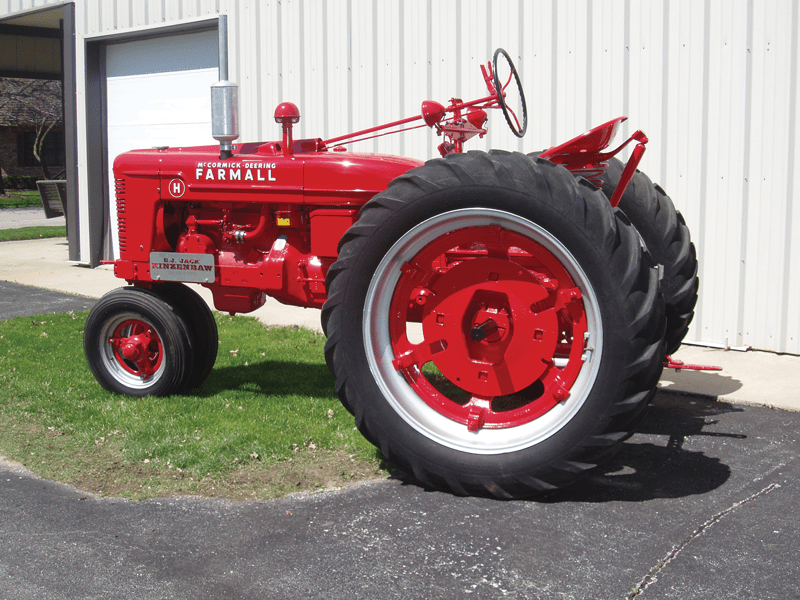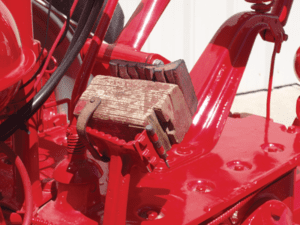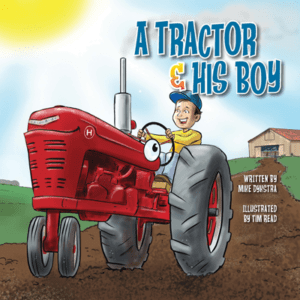Eugene “Jack” Kinzenbaw, Jon’s father, passed away in 1982. He was a World War II veteran who served overseas in the U.S. Army. One of the first things he did upon returning to Iowa was purchase a Farmall “H,” which was eventually sold and replaced by a newer tractor. Jack’s passing prompted Jon to search for the “Old H,” which his father had modified just for young Jon. Read the story in Jon’s own words.
 It was the first tractor I ever rode on and the first one I drove. By the time I was five years old, I could stand on the left axle and hang onto the light post and the back of the seat. As I got older, I could stand farther down on the draw bar and ride there. I spent countless hours riding and watching what was going on. I can distinctly remember the day Dad picked me up and put me on the seat, shifted the “H” into low gear and, at an idle, started across the barnyard. Dad stepped off and walked along behind. I looked back and saw that he wasn’t on it — he wasn’t even touching the tractor — and I knew that I was driving it! I can remember that as if it was yesterday and I could take you out to within five feet of where that took place in our old barnyard.
It was the first tractor I ever rode on and the first one I drove. By the time I was five years old, I could stand on the left axle and hang onto the light post and the back of the seat. As I got older, I could stand farther down on the draw bar and ride there. I spent countless hours riding and watching what was going on. I can distinctly remember the day Dad picked me up and put me on the seat, shifted the “H” into low gear and, at an idle, started across the barnyard. Dad stepped off and walked along behind. I looked back and saw that he wasn’t on it — he wasn’t even touching the tractor — and I knew that I was driving it! I can remember that as if it was yesterday and I could take you out to within five feet of where that took place in our old barnyard.
 By the time I was seven, I was driving it more regularly, and by the time I was nine, I did a lot of work in the field. My dad had an off-farm job for a time, so I would come home after school and plow, disc or do whatever was to be done with that particular tractor, but only after my dad made some alterations. Dad was a mechanical kind of a guy and had a real knack for fabricating. He made a clutch block because my leg wasn’t long enough yet to push the clutch pedal. The clutch block was a 4” x 4” piece of oak. It was fastened to a two-and-a-half inch door hinge. Half of the hinge was screwed to the wooden block. On the other half, he drilled holes and bolted it to the side of the clutch pedal. He cut a section of car tire and put it on top of the block so that my foot wouldn’t slip off. When I drove the tractor, I swung the block into place and latched it. When Dad drove, he didn’t have to take the block off, he just unlatched it and flipped it out to the side. When I was about 10 years old, I was tall enough that I didn’t need the block anymore, so we unbolted it and hung it up in the shop, and it stayed there for decades.
By the time I was seven, I was driving it more regularly, and by the time I was nine, I did a lot of work in the field. My dad had an off-farm job for a time, so I would come home after school and plow, disc or do whatever was to be done with that particular tractor, but only after my dad made some alterations. Dad was a mechanical kind of a guy and had a real knack for fabricating. He made a clutch block because my leg wasn’t long enough yet to push the clutch pedal. The clutch block was a 4” x 4” piece of oak. It was fastened to a two-and-a-half inch door hinge. Half of the hinge was screwed to the wooden block. On the other half, he drilled holes and bolted it to the side of the clutch pedal. He cut a section of car tire and put it on top of the block so that my foot wouldn’t slip off. When I drove the tractor, I swung the block into place and latched it. When Dad drove, he didn’t have to take the block off, he just unlatched it and flipped it out to the side. When I was about 10 years old, I was tall enough that I didn’t need the block anymore, so we unbolted it and hung it up in the shop, and it stayed there for decades.
Dad also modified the throttle. It was slipping out of the notches and it wasn’t holding the RPM. Instead of running to town to buy a new throttle, Dad took the emergency brake lever out of an old Chevy truck, shortened it, and used his brother’s welder to put it on the tractor. He located it to the right of the steering wheel so it was easier to reach.
In 1956, Dad traded the “H” for an “M” Farmall. I was glad to see it go because we got a newer, better tractor. We lost track of the old “H,” and when I started looking for it after Dad’s death, it didn’t look very promising. The dealer had gone out of business and the records were destroyed. I had long since forgotten what the serial number was. Over the next 11 years, I looked at literally every “H” Farmall I could find, and I would always take a second look to see if I could recognize anything on it. In 1993, my son Jonathan and I were at the county fair on a Friday night. Heavy rain forced us into the exhibits building, and I started looking at the woodworking and other projects. One of the exhibits was a photo project. A young man by the name of Tanner had taken five photos of old, rusty tractors sitting out in the weeds. I got up close to one photo, which had a blue ribbon on it and, thanks to my new bifocal lenses, I could see this one tractor with a hand throttle that was different. It was the throttle that my dad had made. It never occurred to me that the tractor would still have that old handmade throttle. So I looked around the fairgrounds, found Tanner’s mother and asked if, by chance, that was a tractor they owned. She said yes, it was. I asked if it was a tractor they would consider selling.
A couple of days later, her husband, Bruce, said he would take four or five hundred dollars for it. I cautiously told him that it was pretty rough, although the tires, the same ones Dad had put on the “H” shortly before he sold it, were still in amazingly good condition. But it had been outside and it didn’t run anymore, so I offered him $400. He said to come and get it, and after we winched it onto a trailer I wrote out the check. I asked Bruce if I should put his name on it, and he said, no, give it to his wife Pam. So I gave her the $400. Then I went to my pickup truck to show the family, who were all standing there, the oak 4” x 4” with the hinge on it that my dad had made. And all those years later — 37 to be exact — the other half of the hinge was still on that clutch pedal, and the two pieces fit together. After Bruce saw that, he said, “Well no wonder you wanted to buy the tractor,” and right away he knew that I would’ve given him his $500, and probably a lot more to get the tractor. I thought the least I could do would be to give him the other hundred dollars. So I wrote out another check on the spot and was about to write Pam’s name on it when it occurred to me that Tanner was standing there, and it was his photo entry that had led me to the tractor, so I gave Tanner the hundred bucks. Tanner’s eyes were as big as baseballs; he was really excited.
A year later, I was back at the county fair and I ran into Pam. She said, “Jon, guess what Tanner asked me about a month ago? What could I take pictures of this year that Kinze would want to buy?” So perhaps that was the beginning of a young man who became an entrepreneur. He was ready to spend some of that money he had earned from the first photo to buy more film and take more pictures in hopes of doing it again.

As visitors tour the Kinze Innovation Center located at Kinze’s headquarters, one of the favorite displays is Jon Kinzenbaw’s boyhood tractor and the story behind it. A Tractor & His Boy, the second book of The Kinze Crew series, is told through the voice of the tractor, “Grandpa H.” He tells the story of how Jon was driving him before Jon could reach his pedals, and how they were separated for many years before being reunited.
Written by Kinze creative services specialist Mike Dykstra and illustrated by Tim Read, the story of Jon and the discovery of his boyhood tractor is brought to life.
Story Notes
The preceding story is an excerpt from Jon Kinzenbaw’s book, 50 Years of Disruptive Innovation, second printing, ©2021, Kinze Manufacturing, Inc.
Jon’s childhood tractor is on permanent display at Kinze’s Innovation Center in Williamsburg, Iowa. Plan a trip to Kinze to see the tractor, Kinze innovations, and the factory for yourself.
Additional Information
Purchase the book, 50 Years of Disruptive Innovation, for this story and many others about Jon’s early years and the growth of Kinze.
